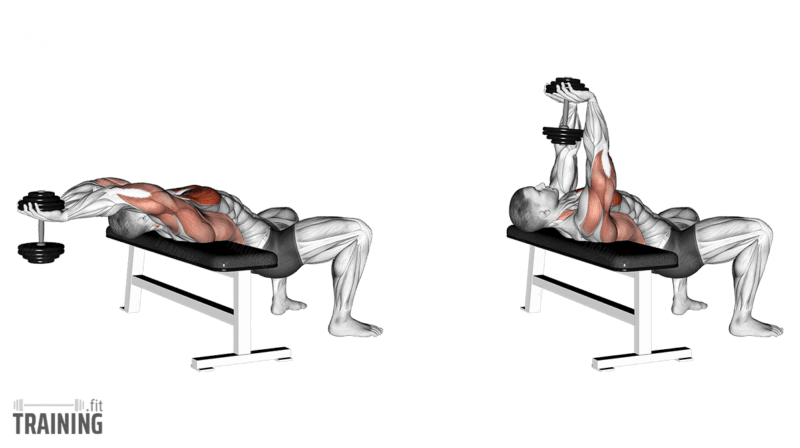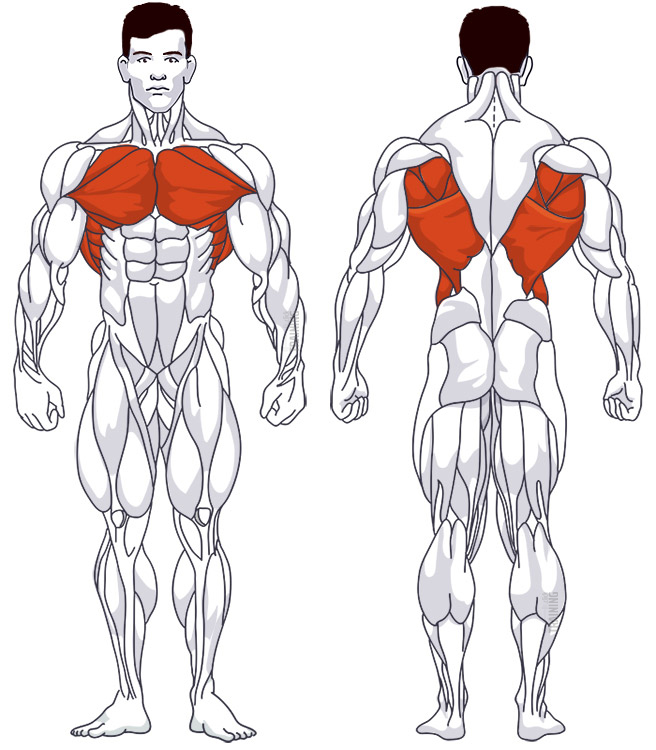Pull-Over
Compound exercise, Free weightsOverview

Main muscles
- Chest: Large pectoral muscle
(Musculus pectoralis major) - Chest: Anterior sawtooth muscle
(Musculus serratus anterior) - Back: Large round muscle
(Musculus teres major)
Training plans
Pull-Over is a suitable substitute for similar exercises in Chest training or as a supplement to various training plans.
Pull-Over: Basics and alternatives

Involved main muscle groups:
Pull-Over
Pull-Overs, also known as Overhead Pulls, are a classic exercise for building chest and back muscles. To do this exercise, lie on your shoulder blades and neck while lowering a dumbbell behind your head with straight arms.
This exercise can be quite challenging, so it’s better suited for advanced trainees.
If you’re looking for an alternative exercise for your back, the Lateral Pull-Down is a good option since it has a similar movement pattern to the Pull-Over. For the chest, you might consider Flyes, which stretch the chest muscles in a sideways motion (not upwards).
Correct Execution
Using the right dumbbells for Pull-Overs is crucial, just like with Dumbbell Triceps Extensions or Dumbbell Skull Crushers. Avoid dumbbells with smooth grips as the spring clips are typically too weak for this exercise. Also, adjustable dumbbells aren’t recommended since the lateral load on the weight plates isn’t designed for it.
Dumbbells with stable screw locks or fixed weights are the best choice for Pull-Overs. But before you start, test if the dumbbell can handle the load.
You can lie on the weight bench either in a transverse or longitudinal position. Both positions work the back and chest muscles equally. However, the transverse position requires more lower body stabilization, which puts more strain on your core. Since the exercise execution is more complex and demanding, starting with a longitudinal orientation is usually better.
As mentioned earlier, you can adjust your elbow position slightly to focus on either the chest or back. For the chest, keep your elbows fairly straight and parallel. For the back, turn your elbows slightly outward and lower the weight further down.
Video Tutorial
Step-by-Step Instructions
Grab the dumbbell, sit down at one end of the weight bench, and hold the dumbbell in one hand on your thigh.
Lie on your back in a longitudinal position, bringing the dumbbell with you and holding it firmly on your chest.
Change your grip and position your hands under the weight plates (see video tutorial). Hold the dumbbell across the inside of the weight plates.
Form a “bridge” similar to the bench press. Press your shoulders and buttocks into the cushion of the weight bench while forming a slight hollow back.
Straighten your arms with a slight bend in the elbows and lift the dumbbell over your chest. Adjust your elbows according to your muscle focus. This is your starting position.
Lower the weight down behind your head, moving your arms straight back at the shoulders. Your elbows should only bend a little more, but not fully fold. End the downward movement when your forearms are parallel to the ground. The further you lower the weight, the more the back is involved, but the shoulders are also loaded. Hold the stretched position for a brief moment before returning to the starting position.
Common Mistakes and Injuries
Keep your elbows slightly bent during the exercise and don’t change the angle too much. A slight change in the angle at which you bend your elbows is fine, but excessive bending and extending shifts the focus from your chest or back to your triceps.
Start with light weights so you can learn the movement as cleanly as possible and distinguish between chest and back focus.
To target the lat muscles, the weight must be lowered further down. However, this movement can put a lot of stress on the shoulder joints, depending on your personal anatomy. So, listen to your body and stop training if you feel shoulder pain. Other exercises for the upper back are usually less problematic in this regard and equally effective.